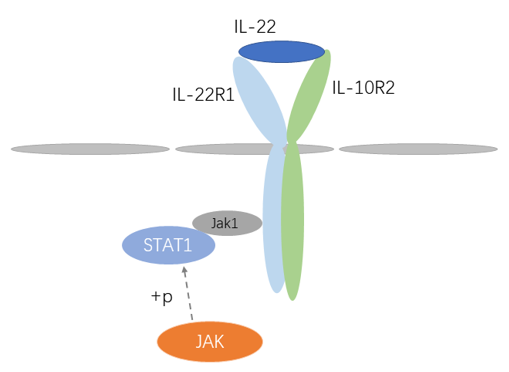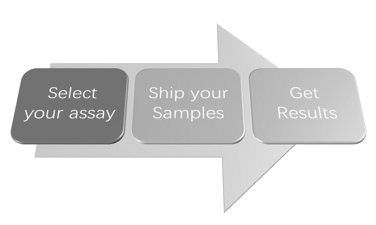Introduction
IL-22 is a member of the IL-10 family and is expressed by different types of lymphocytes, including innate and acquired immune cells, such as Th17 cells, Th22 cells, NK cells, CD8+ T cells and monocytes. IL-22 has many biological effects. It can protect organs or promote disease development, acting on toxic hepatitis, steatohepatitis and T cell-mediated hepatitis, etc. In addition, it also plays an important role in regulating inflammatory response, and the expression of IL-22 is abnormal in many autoimmune diseases.
Mechanism and Function
The receptors of IL-22 are IL-10R2 and IL-22R1 respectively. Among them, IL-10R2 is a type II cytokine receptor, which is widely distributed and expressed on almost all cell surfaces. IL-22R1 is also a type II cytokine receptor, mainly distributed in urothelial cells, digestive tract and respiratory tract mucosal cells. IL-10R2 must be combined with IL-22R1 to play a role. After they are combined, they have the ability to mediate IL-22-induced signal transducer and activator of transcription (STAT) activation. The main pathway of IL-22 is the JAK-STAT pathway. IL-22 and IL-22 receptor form IL-22-IL-22R1-IL-10R2 complex to induce phosphorylation and activate tyrosine kinase. The activated tyrosine activating enzyme phosphorylates tyrosine residues on IL-22R1, and then STAT binds to the phosphorylated tyrosine residues. JAK then phosphorylates the IL-22R1-STAT complex.
IL-22 is related to many diseases. IL-22 can resist microbial infections, induce acute inflammatory mediator responses, enhance natural immunity, and participate in cell proliferation, apoptosis and other processes by affecting important factors in the signal pathway. IL-22 plays an important role in various tumors. In colon cancer patients, IL-22 inhibits tumor cell apoptosis and promotes tumor growth and metastasis through the activation of STAT3. In lung cancer, IL-22 induces phosphorylation of STAT3 to promote the proliferation of lung cancer cells. In addition, IL-22 is also closely related to gastric cancer.
IL-22 plays an important role in inflammation. In multiple sclerosis, IL-22 and IL-17 combine with receptors to destroy the blood-brain barrier, allowing peripheral Th17 to enter the central nervous system. After that, high expression of granzyme B kills neurons, promoting the aggregation of neutrophils and aggravating the inflammatory response of the central nervous system. IL-22 also plays an important role in rheumatoid arthritis. The expression of IL-22 in patients' synovial tissue and synovial fluid is higher. IL-22 promotes the formation of osteoclasts by up-regulating the expression of receptor activator of nuclear factor kappa-B ligand (RANKL) in fibroblasts of the patient's synovium, thereby aggravating arthritis. IL-22 is pro-inflammatory in the skin and hair. IL-22 can promote the proliferation of keratinocytes and epithelial cells, induce keratinocyte migration, etc., leading to thickening of the epidermis. IL-22 can also play a protective role in inflammation. IL-22 can act on Th2 and inhibit the production of IL-4, so IL-22 can have a certain effect on asthma. IL-22 can also protect liver cells in the inflammatory response of the liver. After STAT3 is activated by IL-22, it can up-regulate a series of anti-apoptotic cells and mitogenic cells. In addition, IL-22 can promote inflammation caused by microbial infections in the gastrointestinal tract. It can also play a protective role in the intestinal tissues infected by Toxoplasma gondii. By maintaining the integrity of the epithelial barrier, IL-22 can organize the spread of bacteria, and help eliminate pathogens by inducing different antibacterial proteins.
 Fig 1. Mechanism of Signaling
Fig 1. Mechanism of Signaling
Creative Proteomics can provide cytokine detection platform for scientific research. According to different purposes, our dedicated analysts will customize exclusive solutions for you. We aim to provide customers with high-quality and convenient services to help you accelerate the progress of your project.
Our cytokine detection service includes but is not limited to:
- Quantitative and qualitative detection of cytokines in different species
- Quantitative and qualitative detection of cytokine antibodies
- Quantitative and qualitative detection of single/multiple cytokines
Sample requirements
- Sample Types-Blood, serum, plasma, cerebrospinal fluid, cell culture supernatant, tissue homogenate, cell culture medium, urine, tumor, etc.
- Sample Volume-It is optimal for at least 200µl of each sample. This volume allows for triplicate testing of each sample.
Our advantages:
- Efficient design: Multiplex reaction detecting in various methods are available, which can be selected according to different samples and requirements.
- Sensitive detection: High-quality antibodies are used in the detection process to improve detection specificity and accuracy.
- Reliable results: The feedback results are professional and efficient.
Technology platform:
We mainly provide the Luminex cytokine detection platform. Luminex uses fluorescently encoded microspheres with specific antibodies to different target molecules. The different microspheres can be combined freely to a certain extent so that up to 100 analytes can be tested multiple times simultaneously in a single experiment.
The Luminex cytokine assay platform has the following advantages:
- Multiple detection: simultaneous detection of 100 biological targets
- Short experiment time: 1-3 weeks
- High sensitivity: the lower limit of accurate quantification is as low as 0.1 pg/mL
- Save samples: only need a sample volume as low as 25 μL
- Time saving: the experiment process only takes 4 hours
For your different needs, we can also provide the following detection methods:
- Enzyme-linked immunosorbent assay (ELISA)
- Flow cytometry
Workflow

For more information about the IL-22 detection service or need other detection requirements, please contact us.
References:
- Aujla S J, Chan Y R, Zheng M, et al. IL-22 mediates mucosal host defense against Gram-negative bacterial pneumonia. Nature Medicine, 2008, 14(3):275.
- Cella M, Fuchs A, Vermi W, et al. A human natural killer cell subset provides an innate source of IL-22 for mucosal immunity. Nature, 2009, 457(7230):722-725.



